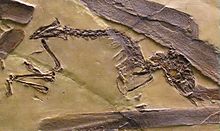Prolagus oeningensis
| Prolagus oeningensis | |
|---|---|

| |
| Scientific classification | |
| Domain: | Eukaryota |
| Kingdom: | Animalia |
| Phylum: | Chordata |
| Class: | Mammalia |
| Order: | Lagomorpha |
| Family: | Ochotonidae |
| Genus: | †Prolagus |
| Species: | †P. oeningensis
|
| Binomial name | |
| †Prolagus oeningensis König, 1825
| |

| |
| Synonyms | |
| |
Prolagus oeningensis is an extinct lagomorph and the type species of its genus, Prolagus. It lived from 15.97 to 7.75 Ma, existing for about 8 million years.
Range[edit]
The species has been found in various locations in Europe and Asia. It was named after the town of Öhningen in Germany, its type locality in the Upper Freshwater Molasse.[4]
Diet[edit]
This species was possibly a herbivore like other living lagomorphs.
Notes[edit]
References[edit]
- ^ a b Ge, Deyan; Wen, Zhixin; Xia, Lin; Zhang, Zhaoqun; Erbajeva, Margarita; Huang, Chengming; Yang, Qisen (April 3, 2013). "Evolutionary History of Lagomorphs in Response to Global Environmental Change". PLOS ONE. 8 (4:e59668): e59668. Bibcode:2013PLoSO...859668G. doi:10.1371/journal.pone.0059668. PMC 3616043. PMID 23573205.
Table_S1.xls
{{cite journal}}: External link in|quote= - ^ "The Paleobiology Database. †Prolagus oeningensis König 1825 (pika)". Retrieved 2015-03-12.
- ^ Wilson & Reeder's Mammal Species of the World. "Prolagus". Smithsonian National Museum of Natural History.
- ^ Ellen Boon-Kristkoiz (2003). "Prolagus oeningensis (Lagomorpha, Mammalia) from the Middle Miocene of Mühlbach am Manhartsberg,Lower Austria" (PDF). Annalen des Naturhistorischen Museums Wien. 104 A: 293–296.
Additional references of the Paleobiology Database[edit]
- ^ Antunes, M. T.; Mein, P. (1981). "Vertébrés du miocène moyen de amor (Leiria) - importance stratigraphique". Ciências da Terra. 6: 169–188.
Paleobiology Database: Amor, point 1 ("premiere gisement" of Zbyszewski)", Amor, points 2 to 5 (Miocene of Portugal) - ^ Buffetaut, E.; Crouzel, F.; Juillard, F.; Stigliani, F. (1984). "Le crocodilien longirostre Gavialosuchus dans le Miocene moyen de Polastron (Gers, France)". Geobios. 17 (1): 113–117. Bibcode:1984Geobi..17..113B. doi:10.1016/s0016-6995(84)80009-1.
Paleobiology Database: Polastron (Miocene of France) - ^ Heissig, K. (1989). "Neue Ergebnisse zur Stratigraphie der mittleren Serie der Oberen Süßwassermolasse Bayerns (New results on the stratigraphy of the middle series of upper Freshwater Molasse, Bavaria)". Geologica Bavarica. 94: 239–257.
Paleobiology Database: Ziemetshausen 1b, 1a (Miocene of Germany) - ^ Ginsburg, L.; Bonneau, M. (1995). "La succession des faunes de mammiferes miocenes de Pontigne (Maine-et-Loire, France)". Bulletin du Muséum National d'Histoire Naturelle. 4 (2–4): 313–328.
Paleobiology Database: Pontigne 4 (marine) (Miocene of France) (les Buissoneaux) - ^ Böttcher, R.; Heizmann, E. P. J.; Rasser, M. W; Ziegler, R. (2009). "Biostratigraphy and palaeoecology of a Middle Miocene (Karpathian, MN 5) fauna from the northern margin of the North Alpine Foreland Basin (Oggenhausen 2, SW' Germany)". Neues Jahrbuch für Geologie und Paläontologie, Abhandlungen. 254 (1/2): 237–260. doi:10.1127/0077-7749/2009/0011.
Paleobiology Database: Oggenhausen 2 (Miocene of Germany) - ^ Additional contributors to utilized records of Paleobiology Database (authorizers supplying these records) include Johannes Mueller, Philip Mannion, John Alroy, Mark Uhen.
